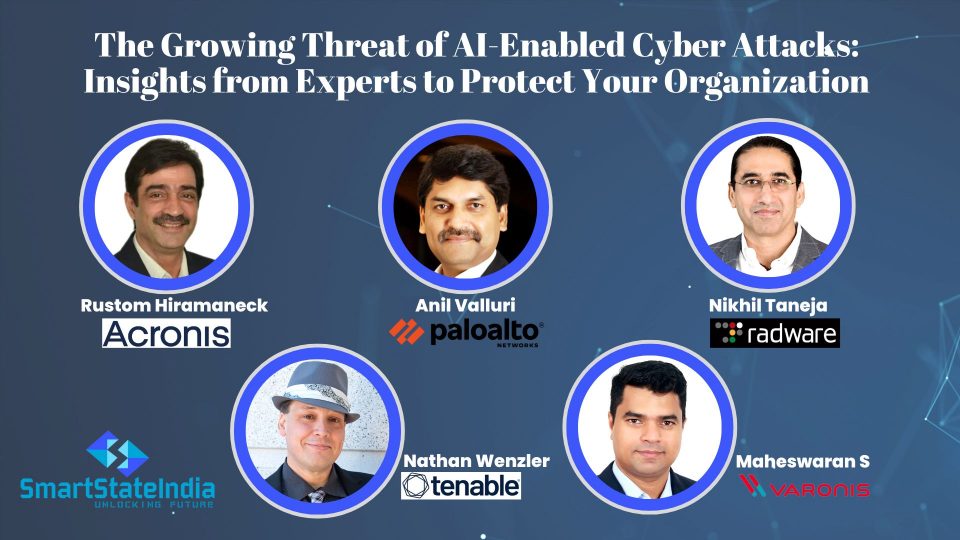Did you know that according to Cybersecurity Ventures, cybercrime is projected to cost the entire world $10.5 trillion annually by 2025, this is up from $6 trillion in 2021. And, this is expected to grow exponentially with the rise of artificial intelligence (AI), which has made cyber attacks even more sophisticated and difficult to detect, thus posing a severe risk to businesses and their employees. For instance, in the finance department of a large corporation, unsuspecting employees fell prey to a phishing email that activated a ransomware attack, leading to the organization losing access to its critical data. This incident highlights the increasing danger posed by AI-assisted cybercrimes and how they can devastate businesses. From deepfakes to AI-powered spear phishing, today’s cyber attacks are becoming increasingly difficult to detect and defend against. A recent study found that 88% of organizations globally have experienced at least one AI-related breach. As the threat of AI-enabled cyber attacks continues to grow, enterprises must stay ahead of the game with a robust cybersecurity strategy. In this article, we’ll explore the implications of AI in cybercrime and discuss how businesses can protect themselves from these emerging threats.
The Potential Threat of AI-Enabled Cyber Attacks

“Cybercriminals have already been using AI/ML in recent years to automate their attacks and make them more efficient. With the appearance of ChatGPT, it took another large step further. AI can be used to create phishing emails in various languages, simple malware, find obvious vulnerabilities in web applications and automate the attack chain. Acronis is constantly monitoring the cyber threat landscape with its Cyber Protection Operation Centers (CPOC) and tweaking detection capabilities where needed. Hence the current challenge is mostly the increase in the frequency of attacks and ensuring that AI-generated phishing email texts are detected and blocked early in the attack chain,” said, Rustom Hiramaneck, General Manager, India and South Asia, Acronis.
AI can also be used to enhance the effectiveness of other types of attacks, such as distributed denial-of-service (DDoS) attacks. By using AI algorithms to analyze the target system’s weaknesses, cybercriminals can launch a more targeted and effective attack, potentially causing significant damage to an organization’s infrastructure. The potential risks of AI-enabled cyber attacks are significant. Businesses can suffer financial losses, reputational damage, and even legal liability if they fail to protect their sensitive information.
Challenges in Identifying AI-Enabled Cyber Attacks
AI-enabled cyber attacks present unique challenges for cybersecurity firms in detecting and preventing them. One of the primary challenges is that AI algorithms can analyze large amounts of data quickly and identify vulnerabilities that are hard to detect manually. Attackers can use AI to find new vulnerabilities in systems or bypass existing security measures, making it harder for organizations to protect themselves.

Anil Valluri, Regional VP and Managing Director of India and SAARC, Palo Alto Networks, highlighted the challenges of detecting AI-assisted threats, “Identifying and addressing AI-enabled cyberattacks can pose unique challenges due to their sophisticated and constantly evolving nature. Firstly, it can be difficult to attribute an AI-enabled attack to a specific actor as they can be executed remotely and involve multiple layers of obfuscation. Secondly, with AI-enabled attacks, attackers can leverage the scalability of AI to launch attacks on a massive scale, further complicating the detection and response process for victims. Thirdly, AI attacks built with techniques such as adversarial machine learning are designed to evade detection by traditional security systems – a nightmare for enterprises still dependent on legacy security systems.”
Another challenge in detecting AI-enabled cyber attacks is that they can mimic legitimate user behaviour. Attackers can use AI to generate fake social media profiles, create realistic phishing emails, and even launch automated attacks that appear to be from trusted sources. Additionally, as AI continues to evolve, so do the methods used by cybercriminals to carry out attacks, making it a challenge for cybersecurity firms to keep up.
Use of AI Evolving in Cyber Attacks – Upcoming Trends
As AI technology evolves, cybercriminals are finding new ways to use it to their advantage. One emerging trend is the use of deep learning algorithms to create sophisticated phishing emails that are almost indistinguishable from legitimate messages. These emails can even contain personalized information that is tailored to the recipient, making them more convincing and harder to detect.

Talking about how AI-assisted cyber threats are evolving, Nikhil Taneja, VP & MD, Radware, added, “Going forward we see AI will become a bigger problem when it comes to the Cyber threat landscape. When applied to Large Datasets AI can help attackers quickly change/modify the attack patterns to evade traditional security. Constantly changing malware signatures can help attackers evade static defences such as firewalls and perimeter detection systems. In addition, AI can render human-like copies and live dialogue via chat. As AI enables advanced phishing emails and chatbots to exist with a higher degree of realism it can make target Social Media users and capture sensitive details which may lead to crimes that are not limited to just Online crimes.”
Moreover, cybercriminals are using AI to create synthetic media, such as deepfakes, that can be used to manipulate individuals or spread false information. Deepfakes use AI algorithms to create highly realistic images, videos, or audio recordings that can be used to spread disinformation, manipulate public opinion, and even extort money from victims.
An upcoming trend is the use of AI to create “fileless” malware. This type of malware does not create any files on the target system, making it more difficult to detect. Instead, it runs entirely in memory, making it harder for traditional security solutions to detect and prevent these attacks.
Another emerging trend is the use of AI-enabled bots to launch social engineering attacks. These bots can generate convincing messages and interact with users in real time, making it easier to trick them into clicking on malicious links or providing sensitive information. As AI technology continues to evolve, cybercriminals are likely to find new ways to use it to launch more devastating cyber attacks.

In this rapidly evolving threat landscape, it becomes highly challenging for organizations to keep their businesses safe from cybercriminals. Stressing the threat landscape, Nathan Wenzler, Chief Cybersecurity Strategist, Tenable, shared his opinion by saying, “Relying on a fully reactive strategy at a time when the number and effectiveness of attacks are climbing is a no-win solution that is going to keep organizations in a state of constantly putting out fires without ever preventing attackers from causing financial and reputational damage. Most organizations already struggle to detect attacks and breaches in a timely manner and respond to the incident to contain and eradicate the problem. If cybercriminals are able to work even faster and more efficiently, then organizations that continue to operate with the same security strategies are going to struggle to keep up. That inability to defend at the same speed which the attackers are now moving is a far greater threat to most organizations than a new type of attack technique.”
Best Practices for CIOs/CISOs to Protect Against AI-Enabled Cyber Attacks
Given that generative AI, such as ChatGPT, has been proven to increase the sophistication and effectiveness of attack methods such as phishing, the CIOs and CISOs of organizations have to be on their toes all the time. There is no rest and constant vigilance has to be maintained to ensure that security apparatuses are up-to-date so that the precautionary and preventive measures are in place to curb any such cyber attacks.

Sharing his advice to CIOs/CISOs, Maheswaran S, Country Head, Varonis, said, “I would say to them is that there is no panacea or silver bullet that will last forever. No matter how strong a tool or solution may seem, eventually, there will always be an exploit or a workaround. The best practices that can be employed by CIOs/CISOs to navigate this journey, many of which can be clubbed under the umbrella of ‘Zero Trust’. Adopting a principle-based approach to dealing with a rapidly evolving technology is a good way to avoid obsolescence. A Zero Trust approach does this by assuming that breaches will be inevitable, designing protocols and data storage practices under the assumption that no user is to be trusted. This can help ensure that even when AI-enabled cyber attacks are successful, their damage is contained. This has the added benefit of making forensic analysis easier.”
To protect themselves against AI-enabled cyber attacks, CIOs/CISOs should consider adopting the following best practices:
-
Educate Employees: One of the most effective ways to prevent cyber attacks is to educate employees about the risks and best practices. Organizations should provide regular training on topics such as password hygiene, social engineering, and phishing attacks.
-
Implement Multifactor Authentication: Multifactor authentication adds an extra layer of security to login credentials, making it harder for cybercriminals to gain access to sensitive information.
-
Use AI-Enabled Security Solutions: AI-enabled security solutions can help detect and respond to cyber threats in real-time, reducing the risk of damage caused by AI-enabled cyber attacks.
-
Regularly Update Security Measures: Organizations should regularly update their security measures to protect against new and emerging threats.
-
Conduct Regular Security Audits: Regular security audits can help organizations identify vulnerabilities in their systems and take proactive measures to address them.
Conclusion
AI-enabled cyber threats are an emerging danger that organizations must take seriously. Cybercriminals are using AI to launch more sophisticated and dangerous attacks that are harder to detect and prevent. However, by adopting best practices and leveraging AI-powered security solutions, organizations can better protect themselves against these threats and safeguard their sensitive data and assets.



